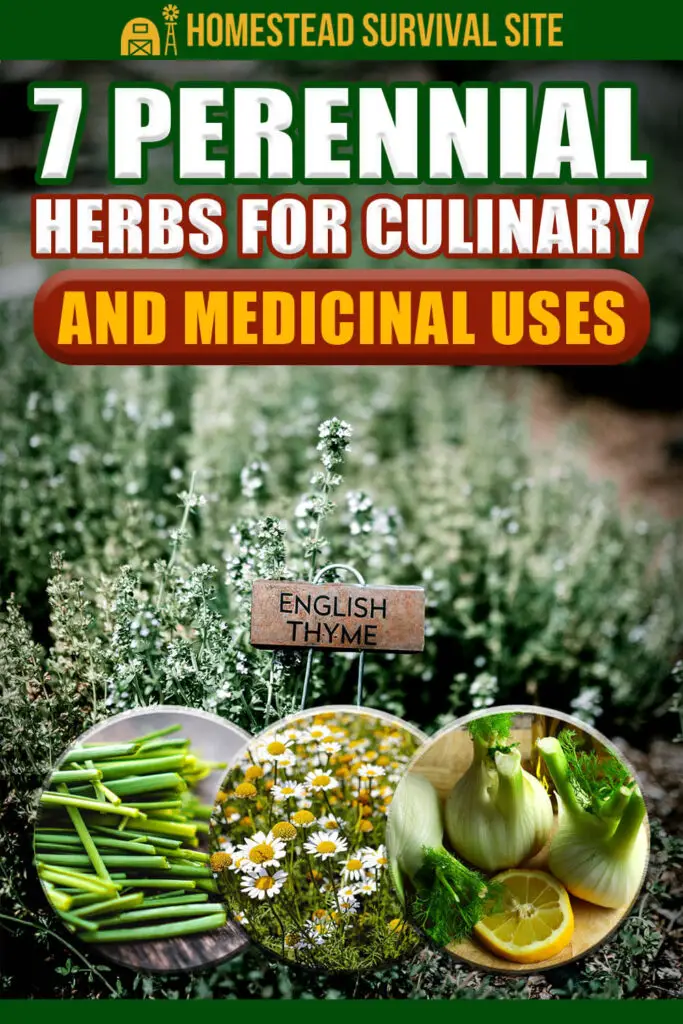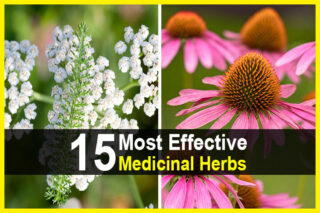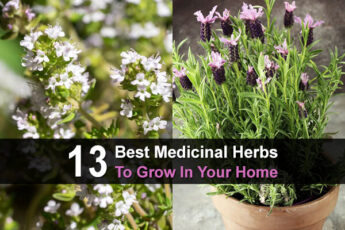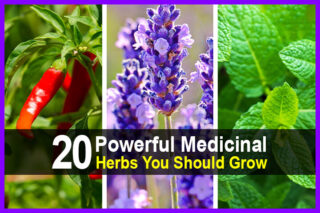Estimated reading time: 13 minutes
Disclaimer: I am not a medical doctor and nothing in this article should be taken as medical advice. Please talk to your doctor before using any of the herbs and/or remedies mentioned in this article.
Credible clinical studies verify that many herbs have significant medicinal benefits… and oh yeah, they taste good, too.
Planting and growing herbs is surprisingly simple, and you don’t need an herb garden to do it. Many people make herbs a part of their regular garden, planting in between the flowers and the groundcover. Herbs also grow well in flowerpots for power who like flower pots on the patio or on the windowsill over the kitchen sink.
Want to save this post for later? Click Here to Pin It On Pinterest!
If you have space, a dedicated herb garden in your yard allows you to consolidate your herbs in one place for easy harvests, whether cooking or making herbal medicines.
Why Perennials?
Because perennials are simpler and tend to be hardier plants. They come back every year without fuss and usually expand and spread to varying degrees.
There’s one perennial exception on this list of 7 because it’s an annual, but it might as well be a perennial given the way it reseeds and returns year after year. This herb is Chamomile. In fact, Chamomile often acts like mint and spreads rapidly year after year, so you’ll probably want to harvest aggressively.
Culinary Versus Medicinal Preparations
When herbs are used for culinary needs, the usage is fairly straightforward. The herbs are typically chopped and either added to a dish while it’s cooking or sprinkled on top of a dish as a garnish.
Medicinal applications get a little more complicated, but not too much. They include:
- Infusions or Teas – As you would expect, this involves dropping parts of the leaves or flowers into gently boiling water for one minute, and then turning off the heat and letting the herb steep in the hot water for an additional 5 minutes. Sweeten with the sweetener of your choice if you like. Honey is most common.
- Emulsified to Release Natural Oils as an Emollient – Most herbs contain natural oils that can be released either in a food processor or crushed with a mortar and pestle. The pulpy mix is then filtered and applied directly to the skin.
- Eaten Either Raw or Cooked. – The natural elements and micronutrients in many herbs don’t require a lot of preparation. Chewing them raw, mixed into a salad or blanched and eaten like cooked spinach can give you a good dose of your favorite herb and all the health benefits.
- Dried and Powdered – This is a common approach for herb roots. The roots are washed, peeled, and dried either in the sun or in a food dehydrator and then pulverized either in a food processor or with a mortar and pestle. The powder is usually added to a liquid and consumed that way.
- Applied Directly to the Skin as a Poultice – This is similar to an emollient except the pulverized herbs are not filtered and typically held in place with gauze or clean fabric. The poultice if often heated slightly to release more of the natural elements and to comfort the affected part of the body.
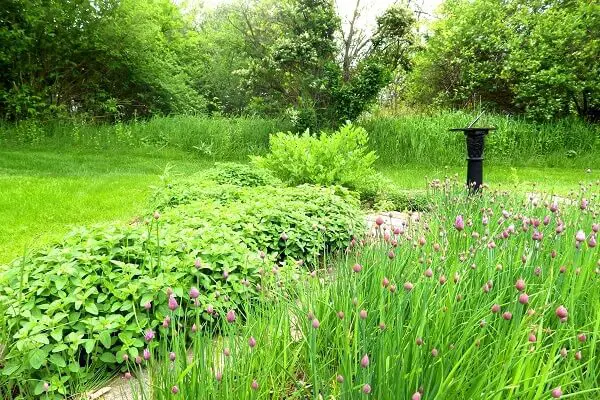
A Note About Herbal Medicine
Unlike prescription pharmaceuticals that provide relief in a fairly short period of time, herbal remedies often take time and consistent usage. The curative and preventive powers of herbs are the result of long-term consumption and regular use until the condition improves, or as a standard, daily, dietary choice to prevent the onset of certain conditions.
There are also potential side effects from overusing certain herbs and we’ll highlight those.
Which parts of an herb are good for you?
All parts of any herb are potentially good for you. This includes the flowers, seeds, leaves, stems, and roots.
Is there a difference between fresh herbs and dried herbs?
Yup. As you would expect, fresh is best. Fresh herbs have more natural oils in a more concentrated form. That’s not to say dried herbs are ineffective. A tea made with dried chamomile flowers will not only taste great but will also serve as an effective treatment for coughs and congestion. But whenever possible, fresh is best.
7 Perennial Herbs to Consider for Your Garden
- Thyme
- Oregano
- Chives
- Chamomile
- Lemon Balm
- Mints
- Fennel
1. Thyme

The ingredients in Thyme that give it medicinal properties include thymol, carvacrol, and rosmarinic acid. The parts used include the leaves, stems, and flowers.
It is used as an analgesic and antifungal treatment, and it is antibacterial and antiviral when used topically on the skin; used for the treatments of coughs and as an expectorant when taken as infused tea; for dental and oral care as an infused mouthwash. Thyme tea will also settle an upset stomach, aid sleep, and soothe a sore throat.
Curiously, thyme oil was also used topically as an insect repellent, and a small smoke-pot of dried thyme leaves will also repel insects.
Thyme is also an excellent culinary herb and is used to flavor sauces, soups, and as a part of rubs on meats and seafood. It is a standard component of a blended Italian seasoning consisting of oregano, thyme, rosemary, and parsley.
Thyme side effects: Not recommended for children, and the concentrated oil should be used sparingly. Excessive use can affect menstrual cycles.
2. Oregano
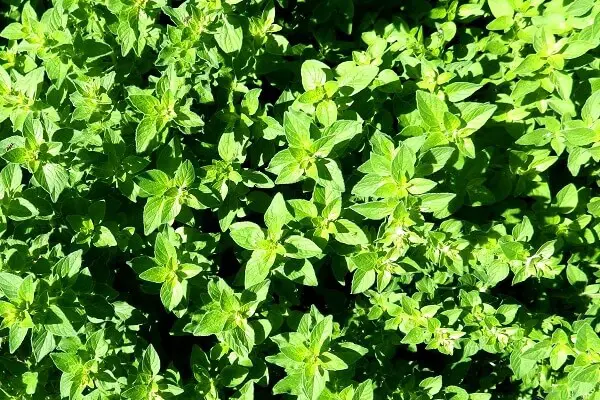
The active ingredients in Oregano that give it medicinal properties include carvacrol, limonene, pinene, thymol, ocimene, rosmarinic acid, and caryophyllene. The parts used include the leaves and the flowers. It has antibacterial and very high antioxidant properties. Some studies indicate it helps to moderate glucose levels as a treatment for diabetes as a result of the flavonoids in Oregano that inhibit DPP-IV. It was taken in ancient times as a treatment for headaches. It also has antispasmodic properties.
It is typically eaten as part of a recipe or infused as a tea. It also is used as an emollient when crushed and reduced to a mash and applied to the skin as a poultice.
Clinical studies have also indicated that the regular ingestion of oregano as a seasoning or tea offers protection heart disease and stroke. These findings were linked to a COX-2 inhibitor in the essential oils to relieve and treat inflammation.
Oregano is another very popular culinary herb used to flavor everything from pizza to spaghetti sauce. It’s also a popular seasoning for chicken, pork, and seafood.
Oregano side effects: Much like thyme, high concentrations of thymol in the essential oil of Oregano can cause skin irritation. There are also some indications that high amounts of Oregano should not be consumed during pregnancy.
3. Chives
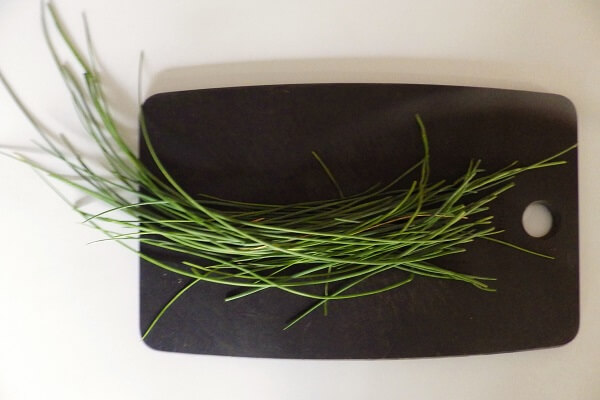
When it comes to the medicinal value of an herb, chives rank as a superfood. Numerous clinical studies have been performed on chives and the results are stunning. The parts of the plant most often used are the grassy stems, flowers, and the small, bulbous roots.
Chives are a member of the allium family of plants which includes all varieties of onions and garlic. Here’s the chive telegram when it comes to medicinal benefits:
- The Journal of the National Cancer Institute conducted a study that showed that men with the highest intake of allium vegetables like chives had the lowest risk for prostate cancer.
- Studies have shown that high intake of chives lowers the risk of esophageal and stomach cancers.
- Animal studies indicate that chives reduced tumor growth.
- Chives help your mood and help you sleep. This is due to a substance called choline that also helps with muscle movement, learning and memory.
- Chives have been shown to reduce inflammation.
- Animal studies indicate that chives increase dopaminergic activity which aids in the treatment of depression.
- Chives contain Vitamin K which contributes to bone strength and acts as a natural blood thinner.
- Chives contain carotenes called lutein and zeaxanthin which have been shown in studies to slow the development of cataracts and improve overall vision.
- And finally, an organic compound in Chives called quercetin has been found to reduce cholesterol and plaque lowering the risk of cardiovascular disease.
Chives are usually consumed with other foods. Culinary uses range from a chopped topping for salads and soups to traditional uses as a garnish for potatoes, scrambled eggs, deli salads like potato salads and egg salads, even steaks, chicken and fish. And get this, chives make an excellent salt substitute. Maybe we should all have a shaker of chives on the table at every meal.
Chive side effects: None.
4. Chamomile
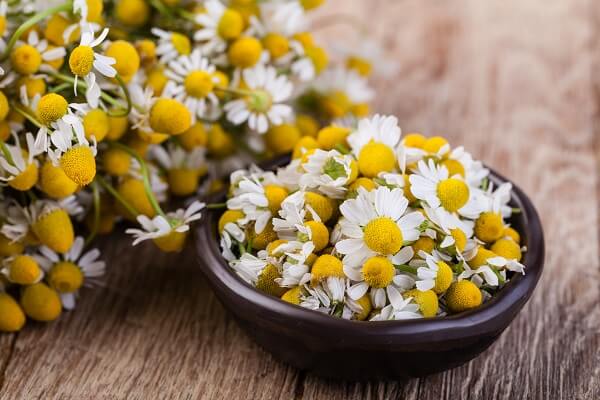
The medicinal value of Chamomile is derived from a complex set of chemicals that include chamazulene, farnesene, bisabolol, rutin, quercimertrin, coumarins, valerianic acid, cyanogenic glycosides, and salicylate derivatives. The parts used are primarily the flowers and the leaves.
The benefits of the complicated combination of bioflavonoids and chemical elements include treatments for anxiety, depression, insomnia, and stress.
It is commonly consumed as an infused tea, but the infusion is also used as a mouthwash, a conditioning rinse for hair or the skin to treat eczema, rashes, and sunburns. It has often been used to aid digestion or to relieve an upset stomach. Chamomile also has anti-inflammatory and anti-bacterial properties.
As a culinary herb, chamomile most often shows up as a beverage in the form of tea that is served either hot or cold. The flowers are also used as a garnish for salads and are very popular as a garnish for oily fish like salmon, mackerel, and herring.
Chamomile side effects: Chamomile is a very mild herb and there are few reported side effects except for individuals allergic to ragweed. It also contains a natural blood thinner known as coumarins and should not be taken with any prescribed blood thinners.
5. Lemon Balm

The medicinal value of Lemon Balm is derived from compounds that include citral, eugenol acetate, citronellal, geraniol, polyphenols, tannin, flavonoids, rosmarinic acid, and triterpenoids. The most commonly used part is the leaves.
Lemon Balm is typically ingested as an infused tea. In fact, the tea can be enjoyed hot or cold and makes a surprisingly refreshing treat on a hot summer day.
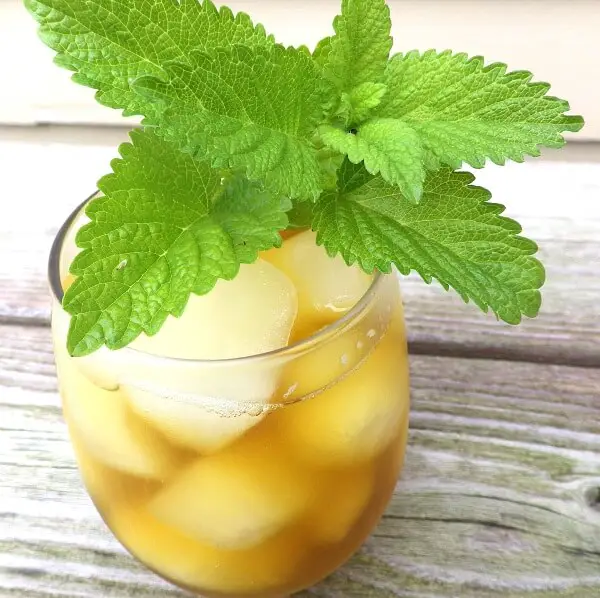
As the name implies, this herb has very strong lemon flavor notes and is actually a member of the mint family. Medicinal uses are similar to Chamomile as a treatment for anxiety, depression, and insomnia. It’s also a mild sedative and not only helps with digestive problems but urinary tract issues.
As an emollient or poultice, it’s used to treat insect bites, cold sores, sunburns, and simple first-degree burns. It’s also effective for nausea and there are some indications it has cardiovascular benefits related to hypertension.
As a culinary herb, Lemon Balm is a natural for all seafood from salmon and bass to clams and mussels. It’s a great addition to a deli salad like tuna fish salad or potato salad and is great as a wonderful hint of lemon in a tossed green salad.
Lemon Balm side effects: None.
6. Peppermint or Spearmint

We’re including a couple of Mint types here because their medicinal properties are identical, although their flavor notes are mildly different. The active ingredients in Peppermint and Spearmint include menthol, menthone, menthylacetate, flavonoids, tocopherols, carotenoids, betaine, choline, azulenes, and rosmarinic acid. The whole plant is usually used for medicinal treatments including the leaves, stems, and flowers.
Mints have been used for centuries to treat congestion due to colds as an infused tea, to relieve headaches and migraines; nerve and back pain, sinus relief, a blood thinner for cardiovascular conditions and yes, an insect repellent when applied topically as an oil.
The typical preparation is as a tea, but mint also has a natural cooling property for burns and insect bites when applied as a poultice. If it doesn’t keep the bugs away at least it will provide some relief from their bites or stings.
It should be no surprise that Mints are often used for dental and oral hygiene. Peppermint and Spearmint have antibacterial properties and leave anyone’s breath fresh and clean.
Culinary uses for Mint abound. A favorite flavoring for candy and a common garnish for savory and sweet dishes and baked goods. A tea served hot or cold is a common recommendation and just about everything else goes well with Mint.
Mint side effects: This is another case where the highly concentrated oils can cause skin irritation, especially in infants and toddlers. The tea hot or cold is benign, but the concentrated oils should be managed carefully.
7. Fennel
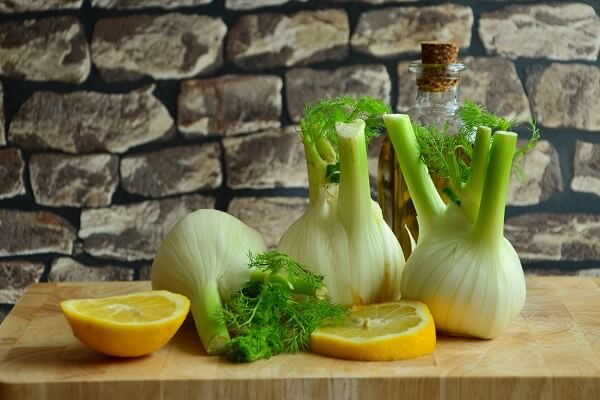
The medicinal properties of Fennel are delivered by chemical elements like anethole, limonene, fenchone, and estragole. The seeds also contain fiber and complex carbohydrates. The parts of the plant used for medicinal purposes extend from the bulb above the root to the stalks and stems to the seeds.
Specific conditions that Fennel has proven effective for include congestive conditions like coughs and colds because of its expectorant effect when taken as an infused tea.
The tea is also good for stomach conditions such as indigestion, or you can just add it as in ingredient in a recipe. It’s also been shown to be an appetite suppressant as a tea. As a digestive aid, it also demonstrates laxative properties regardless of how it’s consumed.
Fennel has significant value as a culinary herb. The bulb is a primary flavor note in Bouillabaisse and the seeds define what we know as Italian sausage. Fennel has a very defined licorice note in all parts of the plant.
Fennel side effects: None.
The list goes on…
This is a shortlist of easy-to-plant herbs that can provide both medicinal and culinary value. There are many more out there, so keep exploring and make your meals tastier and yourself healthier.
Like this post? Don't Forget to Pin It On Pinterest!
Whether you’re cooking hot dogs or roasting marshmallows, your fire pit will get tons of use. Here are 25 plans to choose from.


